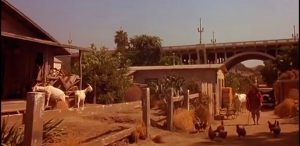My Family (1995) is narrated by one of the characters in the film. We saw this device used in City of God and Like Water for Chocolate. What does the use of this technique tell us about the nature of the story being told?
The first half of the film is done in a theatrical style (with touches of Mexican Folklore and hints of Westside Story); the second half exhibits many of the hallmark traits of neorealism. What do you think the director is trying to achieve by using such an eclectic style?
The artist, Pattsi Valdez, was the set designer. She is a native of East LA, where the film is mainly set. Her paintings often depict domestic scenes of Mexican-American households and exhibit vibrant colors. What do you judge to be the aesthetic effect of the film’s mise-en-scene, specifically the interior spaces? How does the mise-en-scene of this film compare to that of A Better Life?
The director, Gregory Nava, is from San Diego, California and My Family is his second film. He is also known for El norte (1983), Selena (1997), and Bordertown (2006). In addition, he wrote the screenplay for Frida (2002). Nava is one of only a handful of US-Latino directors that have forged successful careers in Hollywood, and he is one of just a few filmmakers whose movies tell stories about Latinos, whether in Latin America or the United States. He did extensive research on East LA before writing the screenplay.

All of the scenes depicting East LA in the film are real places, including the family residence, which might seem unlikely since it is shown to be on an unpaved street. The arched structure in the background is the Fourth Street Bridge that connects Boyle Heights (East LA) to downtown. The scenes depicting Mexico were shot in the town of Pátzcuaro, in the state of Michoacán, Mexico.
My Family tells a story about East LA that, like A Better Life, contains a deliberate focus on gangs. However, My Family differs from A Better Life in its scope and tone: It attempts to present a complex portrait of the largest and most historically significant Mexican-American enclave in the US that honors its inhabitants without ignoring the problems that derive from systemic marginalization and racism. In your mind, is it consequential that this film was made by a Latino director?
60 Minutes aired this report in 1978 on East LA gangs, and in doing so, helped to instill in the popular imagination a grotesquely distorted view of East LA that continues to echo in popular culture today (including in A Better Life). I would like you to watch it before seeing the film because it is important to understand what the pervasive perception of East LA was when Gregory Nava decided to make My Family. How does the vision of East LA underscored in the film contrast with that of the 60 Minutes report from 1978?
Leave a Reply